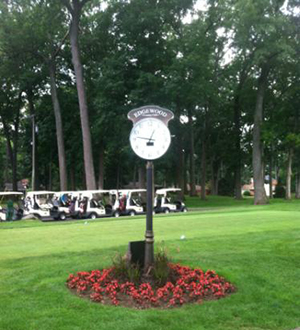Chomko clocks address pace of play problems
Chomko LA, a clock and communications company in Pittsburgh, Pa., has announced solar-powered, GPS-synchronized, waterproof clocks that help golf courses alleviate pace of play problems.

Chomko LA’s clocks, such as this one at Edgewood Country Club, help golf courses address pace of play issues. Photo: Chomko LA
The United States Golf Association kicked off its “While We’re Young” pace of play campaign during the 2013 U.S. Open Golf Championship to address the problem. Golf’s entertainment value decreases when tee times are backed up with play taking more than 4.5 hours. A visual display of time at golf courses creates a sense of pace and keeps golfers aware of the time.
“One aspect of the pace of play problem is the absence of a visual display of time,” said Nick Chomko. “Our dial face is 24 inches and frankly, nobody walks past a 24-inch analog clock without looking at it.”
In the past, golf courses only had the option of installing electric outdoor clocks and/or non-synchronized battery operated analog clocks.
Battery analog clocks have an inherent accuracy problem, however. And the frequency of an analog clock’s quartz crystal will drift, requiring adjustment manually or automatically from an external time source to remain accurate. In addition, the clock’s movement must be built to withstand outdoor elements. Non-waterproof battery analog clocks require the golf course to store these clocks indoors at night and during inclement weather.
Accuracy is rarely a problem with outdoor electric clocks. The problem is the installation costs with trenching electricity. This restricts clock placement because the clock is tethered to an electric cable.
A solar clock can be placed at the most optimal location just by digging a 2′ post hole. In addition, solar clocks designed for outdoor use meet the IP65 waterproof standard, an assurance that they are built for the elements. They also are synchronized to a reliable external time source.
“The clocks are placed at driving ranges, first tees, and key holes–wherever they will have a positive impact on the pace of play,” Chomko said. “The solar power allows golf courses to place clocks at the best locations.”








